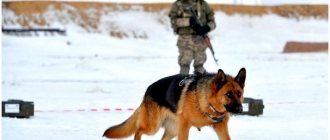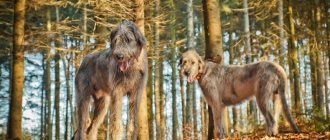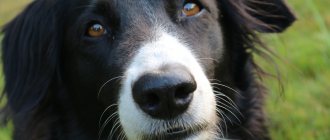Dogs are unique animals. For many centuries, they are infinitely faithful and devoted to humans, occupying different niches in our lives. Some accompany on the hunt, others become faithful companions or protectors. For example, police dogs have saved more than one human life and help in solving crimes. What tasks do service dogs perform and why are they hired? What breeds of dogs are most often used as reliable assistants in human activities?
Why are dogs hired?
In theory, a dog of any breed, with proper training, socialization, and systematic training, can become a service dog, show its maximum potential and be useful to humans.
It is believed that the natural ability of a dog to track its prey by smell (footprints) began to be used in solving crimes, searching and apprehending criminals, starting in 1896. The Austrian investigator Hans Gross convinced the world that our smaller brothers are ideal for investigative work. Thus, in the city of Hildesheim, for the first time, 12 dogs were selected, who completed a special training course and later successfully worked in the police.
The first to use his pet bull terrier in stopping a gang was Scottish policeman Malcolm Gillepsie in 1816. His faithful dog scared the horses on which the criminals were escaping and thanks to which the bandits were neutralized and taken to the police station.
Important! In Russia, dogs were first used in police services in St. Petersburg in 1906. And already in 1909, on June 21, a professional holiday was officially approved - the Day of the canine units of the Ministry of Internal Affairs.
Today it is difficult to imagine the work of intelligence services without the participation of different breeds of dogs. Four-legged friends are used in the police, the Ministry of Emergency Situations, the Ministry of Internal Affairs, the search, border services, and military affairs.
Among dog professions we can distinguish:
- Saperov. They look for explosives and explosive devices by smell.
- Rescuers. Rescue dogs are used in the emergency services of the Ministry of Emergency Situations. They take part in fires. They work on wrecks and in places of natural disasters. They help find people under the rubble. When completing tasks, a bell is tied to the animal's collar. In this way, the dog handler will be able to find the dog, because the dog may accidentally fall into the ruins.
- Border guards. All border services use dogs. They help in the fight against smugglers and prevent illegal crossing of state borders.
- Bloodhound. Dogs, thanks to their well-developed sense of smell, help intelligence services not only in searching for people and detaining criminals “on the trail,” but also in identifying smuggled caches of narcotic or other dangerous substances. Sniffer dogs work in the police and border services.
- Guards, escorts. They work as security guards at sensitive, important strategic facilities.
Faithful four-legged friends significantly facilitate the work of special structures, faithfully performing their difficult service.
In the structures of the Ministry of Internal Affairs, the canine service uses specially trained dogs for:
- establishing the route of criminals;
- protection of important objects;
- examination of territories, terrain, premises, vehicles to search for items that were lost or related to crimes committed;
- odor recognition based on an object given to the dog, seized from detained criminals;
- security of public events;
- search for corpses, people, weapons, drugs;
- to pursue persons who have committed crimes or missing people “hot on their heels.”
Different breeds of dogs are specially trained and used for different jobs.
Boxer
Boxer
The name of the breed indicates that it is a fighting breed. There are two types of boxers: the service boxer and the German boxer. Thanks to their athletic constitution, boxers are able to jump well in height and length, which is what they rely on during training. Boxers' agility and instant reaction are the main qualities of a real police dog.
TOP 5 best dog breeds for police service
Each structure favors different dog breeds. Here are the TOP 5 best dog breeds for police service according to dog handlers and specialists:
- German Shepherd. This breed has unique working qualities, high intelligence, and a balanced disposition. Shepherds learn quickly. They are smart, quick-witted, courageous, hardy, unpretentious in care and maintenance and adapt to various conditions without problems. These are loyal, noble dogs who have saved more than one human life and successfully cope with tasks of varying complexity. Thanks to many years of selection, this breed has significantly improved its working and service qualities. That is why Germans are used not only in the police, but also in other structures.
Belgian Tervuren
The Belgian Tervuren is not a traditional breed, and its name also has a root from the word “terror” (fear), which is exactly what it was supposed to evoke. Everyone is afraid of a big dog, even if he is kind at heart. A Tervuren is a long-haired dog that looks like a wolf, and therefore, as people thought, it is as ferocious as a wolf. But, in fact, this is a kind and friendly dog, but which behaves like a wolf or a lion if necessary to protect the owner. The Tervuren is a good watchdog and search dog.
Features of training police dogs
Security, guard, and police dogs must have a keen sense of smell, developed hearing, and fearlessness.
The dog must come to the defense of the person at any time on command.
Training a four-legged law enforcement officer takes on average from 6 months to a year. Dogs can begin training from four to six months and up to three years of age. The duration of one lesson is 2-2.5 hours. Trainings are held in different places. This is necessary so that the dog does not get confused in an unfamiliar area or environment.
Dog trainers themselves build a training program based on the natural and breed inclinations of the dog. The first training takes place in the form of a game, so that the process captivates and interests the dog. For each correctly executed command or task, the dog receives a reward.
The training uses the so-called contrast and mechanical training methods. In the first weeks, the dog should establish a rapport with its trainer. Only by trusting the person will the dog strictly follow commands and show obedience. Therefore, until the dog gets used to the handler, mechanical training methods are not used. They use the method of encouragement (voice, food motivation).
The mechanical method (physical impact) is used only for adult dogs who have completed the basic training course. Helps develop the dog's protective skills. At the same time, the dog handler should not shout or use violence towards his ward. Otherwise, the dog will begin to show causeless aggression towards people.
- The imitative training method is used to train large groups of dogs. Dogs are pack animals and are often guided by the actions of their fellow dogs. This technique uses experienced dogs and novice dogs.
- Contrast training method. A dog trained using this method does not associate obedience skills with treats or physical impact. That is, he will follow commands without expecting any reward.
- Combined program. For example, a dog can take part in detaining criminals and searching for drugs, weapons, and explosives.
Important! In the first two to three weeks, service dogs develop their own specialization in the process of training and education. Qualified dog handlers and experienced trainers work with the dogs. One trainer or several dog handlers can be assigned to the dog.
The specifics of training police dogs depend on the area in which the four-legged guard will be used. Thus, when training police dogs, special attention is paid to following commands and chasing with live bait .
Rottweiler
Rottweilers are known for their aggressive behavior and energetic nature. While not the biggest dog on this list, he is without a doubt the bravest attack dog that will make the ground burn under the feet of a criminal. He can easily bite off your finger. A criminal will think twice about his actions when meeting a Rottweiler. Taking into account the fighting and aggressive qualities of the dog, which he shows even in puppyhood, during training and training, emphasis is placed on discipline. You must be extremely strict and careful with this dog.
TOP 5 most famous police dogs and their stories
Dogs have saved more than one human life. Some dogs, famous for their exploits and achievements, have gone down in history. Here is a ranking of the TOP 5 most famous police dogs and their stories.
German Shepherd named Gecke
This is the first dog to prove itself in police service. The dog brought from Germany to work in the police department did not immediately become famous. Having gone with the agent to the crime scene, the dog was unable to identify anyone among a large crowd of people, but upon returning to the police station, Gekse immediately rushed at one of the group of suspects. And this was just one of the many crimes that were solved with the help of this dog.
German Shepherd Leo
The unique dog went down in history as a drug-detective dog. During his nine years of service, thanks to Leo, more than three hundred people were arrested who were trying to transport drugs across the border. The German found more than 17 kg of cocaine, 29 kg of heroin, and more than a ton of marijuana. The total cost of the intoxicating arsenal amounted to tens of billions of dollars.
After completing his service, the dog was awarded a state pension and was given shelter at a hotel for older working dogs. For searching for drugs and detaining smugglers, Leo received an honorable place in the Guinness Book of Records.
Golden Retriever Trepp
During his years of service with the Florida Police Department, Retriever Trepp detained more than 100 dangerous criminals and found drugs worth more than 63 billion. dollars.
At demonstrations, the dog found 11 instead of 10 bags of drugs.
Malinois Diesel
Belgian shepherd Diesel served for 5 years in the French unit of the French police unit RAID and became the first dog to die in the line of duty.
Diesel, together with a group of police officers, took part in a special operation in the suburb of Saint-Denis to search for, capture and eliminate Islamic terrorists who carried out terrorist attacks in Paris.
Unfortunately, one year short of his well-deserved retirement, the dog died while inspecting the top floor of one of the buildings during the explosion of a suicide vest. The dog saved its owner at the cost of his life. The Paris police leadership awarded Diesel an honorary award for his courage.
In December 2015, the British charity PDSA awarded the Mary Dickin Medal (British's highest award) to the deceased sheepdog.
Doberman Club
The Doberman Pinscher named Tref is a detective police legend. The brave dog served in the police of Tsarist Russia and during his service helped police officers solve more than 1,500 crimes.
To stop robberies, crimes, and other atrocities, one news about the visit of Club and his owner Dmitriev to one city or another was enough. The criminals left their homes in fear so that the smart dog would not get on their trail.
In 1911, the abilities of a unique bloodhound were used in the fight against terrorists in Bryansk. In addition, the dog was involved in capturing spies, as well as a group of bandits who attacked Lenin’s car.
The procedure for search activities
Despite the fact that the criminal is inclined to cover his tracks, confuse them, and use any tricks, this will not confuse a trained dog and make him lose the trail. Dogs are trained to work with a trail that can loop, be interrupted, change its direction, intersect with roads and pedestrian paths, and follow through populated areas.
The criminal constantly invents new ways to mislead his pursuers: he walks on water, climbs trees and mountains, uses stilts and other means of transportation, and treats his tracks with odor suppressants. A trained dog easily avoids such obstacles on the way to the goal, is able to steadily move in a given direction, and catch up with the criminal. It happens that this may take more than one hour. Having discovered and overtaken the pursued criminal, the dog detains him and waits for the handler.
When the pursuit just begins, the dog can move away by the length of the leash, i.e. at a distance of up to ten meters, following the scent. Immediately before the arrest, the handler unfastens the leash, giving the bloodhound freedom of action. The dog overtakes the offender, rushes to detain him, thereby turning his attention to himself, giving the handler the opportunity to approach in relative safety and end the pursuit. When a criminal is detained, a handler and a dog escort him to the place of temporary detention. During the convoy, the dog is trained to vigilantly observe every movement of the detainee, keep an eye on him and prevent all attempts to attack the conductor or escape from the place of detention.
Do dogs have a pension?
Police dogs have great potential and talents. Brave tailed law enforcement officers take part in special operations every day and have received many honorary awards over the years of their service. Do dogs have a pension and what happens to the four-legged heroes next?
On average, the service life of working dogs of various breeds is 7-8 years, after which their working potential gradually fades away. The retirement age depends on the specialization, purpose of the dog, and state of health.
After their career, brave heroes retire and no longer receive the salary (food) for which they worked. At the end of the last century, unfortunately, retired dogs were destroyed, no matter how humane it may sound. Today, the honorary “old men” are taken by dog handlers and police officers who worked with the animal, because during his service the dog became a reliable companion and friend.
The dogs are also given into good hands, or they remain to live out their lives in the same kennel, never going out on missions again. Retired dogs are maintained using donations, funds from employees, and volunteers.
Honorable Mentions
These are far from the only police dogs you may encounter.
Although they are not as well-known as the varieties on our list, here are some additional famous police dog breeds that you may see on the job.
These are far from the only police dogs you may encounter.
Although they are not as well-known as the varieties on our list, here are some additional famous police dog breeds that you may see on the job.
- Belgian Tervuren
- Golden retriever
- Groenendael
- Border Collie
- English Springer Spaniel
- Rottweiler
Questions about the most popular police dog breeds
What is the ideal age for a police dog?
The ideal age for a police dog is around two years old. The reason for this is that they are at the ideal age to start training. The training will last about six months, after which the dog will be ready to work.
What is the average age of dogs in law enforcement?
The average age of dogs in law enforcement is about six years. This means that half of the dogs are over six years old and half are under six.
What breed of dog is most often used by police officers?
German Shepherds, Dutch Shepherds, Retrievers, Belgian Malinois and Bloodhounds are some of the most commonly used police dogs.
Which police dog is considered the best?
German Shepherd, Labrador Retriever, Doberman Pinscher, Belgian Tervuren, Rottweiler, Giant Schnauzer and Dutch Shepherd are some of the best police dogs.
Which dog breed is the most popular police dog in 2019?
The Labrador Retriever has become the most popular dog breed in recent years.
How much does a shepherd puppy cost?
In the capital, the minimum cost of German Shepherd puppies today starts from 10,000 rubles. The average price for a party is 20-35 thousand rubles. A mixed breed (a puppy whose one of the parents is a German Shepherd) can be purchased for 500-1000 rubles.
Interesting materials:
How to translate text from an image in Google Translator? How to translate text on Facebook? How to translate Telegram? How to convert colors from RGB to CMYK in Corel? How to convert to meters per minute? How to transfer in Sberbank without commission? How to translate in Viber? How to convert Illustrator to vector? How to translate Viber into Ukrainian? How to convert watts to amperes?
Separate play and work
At the training ground in Aparinki there are many sites with simulations of various emergency situations. For example, a site where search dogs train to search for people under rubble.
Yulia gives the signal, and Danya begins to search. He sniffs every corner, sometimes stops and listens. A few minutes pass and the man is found. After completing the work, the dog is given a reward - some kind of treat.
“It’s a game for them, but at the same time they understand that they are working. And they really miss this,” explains Yulia.
She adds that dogs are great at understanding when it's time to fool around and when the serious work begins. And they behave differently in different situations.











